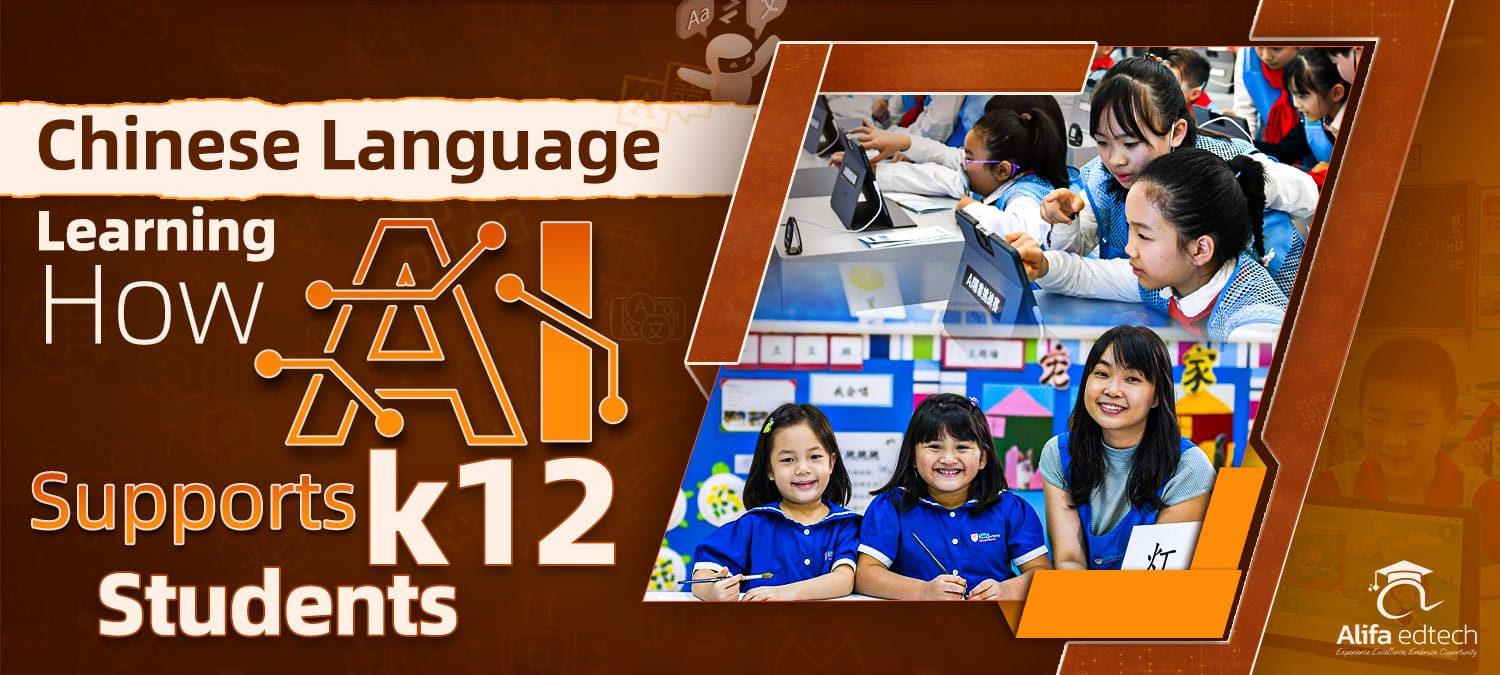Chinese education welcomes more international students in K-12 education every year. Young learners join Chinese primary and secondary schools to discover new opportunities. Yet, they often struggle with Mandarin as their second or third language.
Imagine moving to a place where everyone speaks a different tongue. That happens in Chinese education. Students face tough academic challenges. They must pass standardized tests in a new setting. They might struggle to keep pace with lessons or gain complete access to education.
These kids struggle to make friends in social situations. Aspects of education, such as group activities, become tough without clear communication. The education sector can make the individual student feel lonely or stressed. These emotions can hurt their education and create gaps in understanding.
Have you felt overwhelmed by language gaps? You're not alone. Many parents worry about their individual student's changes.
In this article, you'll discover how AI tools ease these hurdles for K-12 education. Alifa Edtech supports parents like you in China's schools. We keep choices simple. Your child gets a great fit in international or Chinese schools. The future of education depends on the development of education. Jump into easy enrollment now!
Alifa Education Services bridges ed-tech entrepreneurs and policymakers with China's leading AI companies. Get matched with the perfect technology partner for your region.
Book Your Partnership Consultation Today!
Tell us your needs—we'll find your ideal Chinese AI firm match
AI's Role in Modern Language Education
Artificial intelligence is changing how we learn languages around the world. It offers tools that adapt to each student, making lessons fun and effective through intelligence in education.
Key areas include these:
AI-Driven Personalized Learning Paths
AI-powered analytics tools create paths that match your learning pace. With adaptive learning technology, kids get a personalized learning experience. Boring classes fade away! These options tweak lessons based on your skills through a personalized learning experience. That builds innovative talents in education. Do slow steps frustrate you? AI speeds up growth for young adventurers in new places.
Bridging Cultural Gaps with AI Tools
Digital technologies link students to various cultures without much hassle. They allow you to explore traditions without restrictions through digital learning platforms. How does it beat old ways? AI delivers instant feedback and voice checks. In a 21st-century classroom, that helps kids with language bumps feel connected. You'll gain confidence. What holds you back? It unlocks global pals.
Enhancing Speaking Skills Through AI Practice
AI-supported education reforms team you up with AI for speaking practice. Why is it better than before? AI spots errors right away, not like teachers do. Young learners get skills at a rapid pace through innovative talents. Are accents a concern? These tools fix them and spark your shine in education.
AI's Impact on Classroom Integration
Teachers blend AI into daily lessons with clever tech through AI-powered classroom technologies. The shift? It goes from group setups to personal help. K-12 students do well here. You'll notice wins in tests and talks. Does your child adjust overseas? AI makes school warm and easy.
Future Innovations in AI Language Support
AI tools will transform education with cool updates. How do they help? They give feedback that prepares talents for later through AI-supported education reforms. This tech moves fast, unlike stiff old methods. For young learners abroad, it's essential. More reforms with AI will calm your fears in a 21st-century classroom.
AI Tools for Student Adaptation in Chinese Learning
Artificial intelligence makes K-12 classes fun for Chinese studies. It uses tools that fit each student. That's a step up from unpersonalized lessons. Now, specific tools come into play.
Practical options include these:

AI Tools for Interactive Chinese Lessons
Duolingo and HelloChinese are AI-powered tools that create content for fun lessons. They align learning styles with adaptive tech. This helps users enhance vocabulary through quizzes and understand grammar with stories. For pronunciation, they offer speech practice with quick feedback. K-12 kids can use these for daily homework. This builds a deeper grasp. Do boring classes worry you? These platforms turn learning into games.
Teacher Adoption of AI in Daily K-12 Teaching
Teachers can use apps like Wukong Chinese and NihaoKids. These AI tools help with lessons. They adjust to a child's speed. They create text for grammar exercises and tasks. How do they aid? They share views on word growth with tailored tips. Teachers assign homework that matches learning flows. Is tech too much? Start small and watch engagement soar.
Blending AI with Traditional Classroom Activities
AI tutors in apps like ChineseSkill and Studycat Learn Chinese mix with classic methods. They use adaptive tools to clarify Chinese understanding. Students receive ideas through app content that strengthens grammar and speech. Kids use digital platforms to practice vocabulary during tasks. Why make the switch? That spices up routines and deepens knowledge, all while keeping books around. Have you blended apps with old tools?
Want to put your brand in front of families, students, and education-focused readers? We're inviting select partners to advertise with us on our trusted blog.
Want to get featured? Click 'Learn more' and submit a story for us to include.
Addressing Challenges in AI Classroom Integration
Apps like iHuman Chinese and Galaxy Kids Chinese help students learn their way. They craft homework that suits styles and simplify grammar and comprehension. Teachers apply them for speech drills and tips that lift confidence. Does your child hesitate with tech? These apps ease the process and make lessons effective.
Tracking AI's Progress in Student Learning
Apps like Anki and Pleco track growth in Chinese words and understanding. They tweak to paces and show gains in grammar and speech. Parents see how app text helps grasp concepts through charts. Why do this? You'll get views to fine-tune paths. Eager for shifts? Begin tracking today.
Anki App Tutorial Video.
Integrating AI into K-12 Classrooms
Artificial intelligence boosts K-12 spots in Chinese schools. It meshes with curricula through helpful apps. Key areas cover these:
AI Tools for Interactive Chinese Lessons
Chinese schools use apps like HelloChinese and SuperChinese for international kids. These tools build vocabulary with games and fix grammar through exercises. Pronunciation gets quick help, boosting comprehension. Human teachers guide sessions after training. Do distance education worries affect you? Students feel more included.
Teacher Adoption of AI in Daily K-12 Teaching
Teachers use apps like Chinesimple and Migii HSK. This follows education reforms. They boost drills and checks for learners. They also share analytics for growth. Why try them? You will see gains. Training programs prepare educators for easy use.
Blending AI with Traditional Classroom Activities
Schools blend apps like Du Chinese and The Chairman's Bao with old methods. Students use these to learn words and understand stories. Grammar aligns with curricula. Human teachers mix them with group work. Have concerns about blending? It creates a balanced space for all.
Addressing Challenges in AI Classroom Integration
Schools tackle issues with apps like Chinese Pinyin-Learn Mandarin and Quizlet. They fix gaps and hurdles, promoting belonging. Teachers use training to apply these for better performance. Ready to overcome obstacles? These tools make learning fairer.
Chinese Alphabet Pinyin App Tutorial Video.
Tracking AI's Progress in Student Learning
AI tools in schools measure student growth. Apps like Pleco follow standards. They track vocabulary, grammar, and comprehension. This ties into curricula for better outcomes. Teachers review data to adjust lessons. What changes will you notice? It's clear that tracking is beneficial.
PLECO App Tutorial Video.
Beyond Words: AI's Role in Cultural Understanding

AI does more than use words. It helps K-12 students dive into Chinese culture through language. It builds confidence and smooths fitting in through lively tools. Exciting areas cover these:
AI Simulations for Cultural Immersion
AI simulations pull you into Chinese traditions, like festivals and social hints. In South Korea, students try apps for idioms and manners. That encourages critical thinking. Ideas from the Academy of Future Education shape journeys. Does culture confuse you? You'll develop independent thinking for chats. Educational aspects mix fun and progress.
Discovering Chinese Customs via AI
AI tools clarify Chinese ways. They give guides on etiquette and sayings. In the Philippines, apps tie into education trends. South Korea's programs spark independent thinking on norms. What if home seems distant? AI connects you and boosts confidence in new spots. Education ideas guide the path.
Building Bridges with AI in Friendships
AI forges links by checking social hints in Chinese culture. In Myanmar, the Academy of Future Education uses stories to boost critical thinking. You'll handle talks better, enhancing educational experiences. How does it support integration? That fosters independent thinking for strong bonds. Educational aspects evolve with technology.
Virtual Worlds for Global Cultural Insights
Enter virtual spots where AI reveals Chinese etiquette and traditions. Hong Kong students sharpen critical thinking with scenes from South Korean styles. Education's future glows here, blending insights with language. Are fears about fitting in real? You'll build confidence and independent thinking for success. Educational ideas make it simple.
AI Narratives That Connect Cultures
AI stories link Chinese sayings and customs with education. The Academy of Future Education in India offers resources to boost critical and independent thinking. That leads to deeper cultural knowledge. This enriches experiences and shapes futures. Ready to lift confidence? These tales ease integration and create comfort.
Conclusion
AI paves a smarter path in Chinese classes for K-12 kids worldwide. It bridges gaps with useful tools. Does that excite you? Let's wrap up.
AI affects education plans by offering insights on progress. Beijing Normal University and Carnegie Mellon University researchers explored this. Cambridge University Press tools aid learning. Derek Li's work highlights intelligence in education. Ethical issues and privacy, like student data protection, ensure safety. In the Philippines, these build trust.
Benefits include sharper skills for students and simpler tasks for teachers. Kids gain confidence and cultural smarts, advancing education. Teachers adapt with training, reshaping landscapes. How will it help your family? You'll see creativity and links grow.
Alifa Edtech helps expatriate parents navigate China’s education system. We make school selection easy. Your child will find the best fit in international or Chinese schools. Book a free consultation today!
Related Articles















Member comments